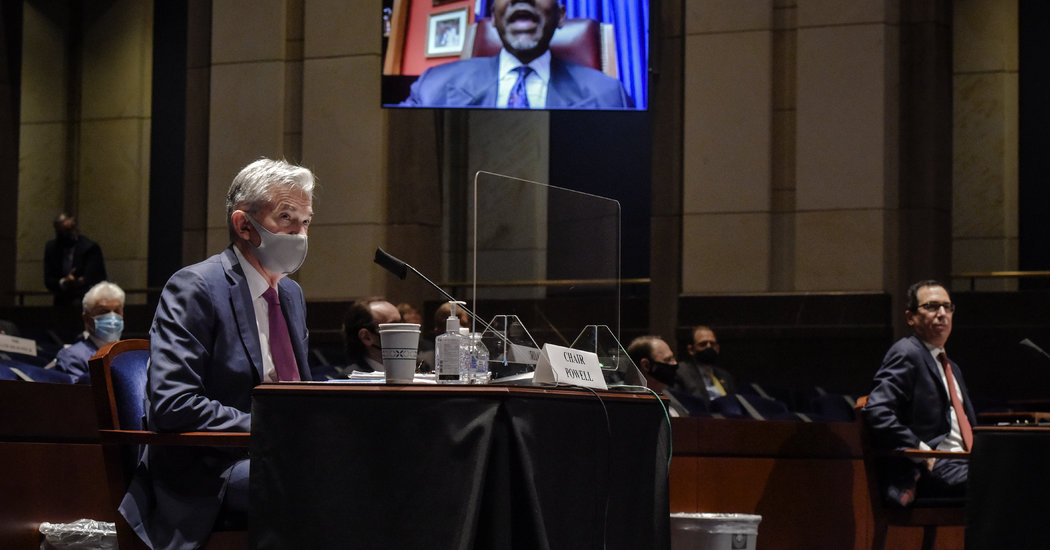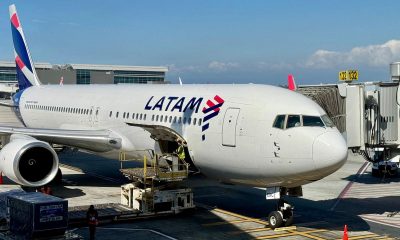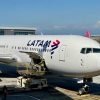ECONOMIC NEWS
Federal Reserve Minutes Show a Litany of Reasons to Worry About Economy
WASHINGTON — Some businesses will not make it through the pandemic-spurred economic crisis. Consumer spending will not fully bounce back even into next year. And there is a serious chance of a double-dip downturn that could permanently scar the American labor force.Those are some of the major points from the minutes released Wednesday of the Federal Reserve’s two-day meeting in which officials and central bank staff paint a bleak picture of what lies ahead for the American economy.In the time since that gathering, held June 9 and 10, officials — including Jerome H. Powell, the Federal Reserve chair — have stressed that the economic outlook is deeply uncertain and have warned that containing the virus pandemic will be crucial to a recovery. But the minutes offer a glimpse into the concerns that occupied the Fed’s full slate of policymakers, 17 in all, when they last met.The officials cited “extraordinary” uncertainty and “considerable risks” to the outlook. A number saw “substantial likelihood” of additional waves of virus outbreaks, with the potential to cause a drawn-out period of economic weakness. And they were concerned that government support could end too early or prove too small to handle the crisis at hand.“Among the other sources of risk noted by participants were that fiscal support for households, businesses, and state and local governments might prove to be insufficient,” the minutes state.Fed officials took some comfort in the fact that hiring rebounded in May, with unemployment dropping to 13.3 percent from 14.7 percent, instead of rising as expected. They said the “data suggested that April could turn out to be the trough of the recession.”Even so, they said it was too early to draw any firm conclusions — and they remained worried about the future.“The recovery in consumer spending was not expected to be particularly rapid beyond this year, with voluntary social distancing, precautionary saving, and lower levels of employment and income restraining the pace of expansion over the medium term,” according to the minutes.Mr. Powell has repeatedly warned that consumers will shy away from high-touch activities — think packed restaurants, concerts and casinos — until health risks subside, making a full recovery unlikely until a cure or effective treatment to the coronavirus is found.His colleagues said voluntary social distancing and structural shifts rooted in the pandemic “would likely mean that some proportion of businesses would close permanently,” even as states moved toward reopening.The Fed’s June meeting was held as reopening plans swung into high gear in many states, but before a recent resurgence in coronavirus cases in parts of the South and West. There were about 23,000 new cases in the United States on June 10, New York Times data shows. That number skyrocketed to about 48,000 on June 30.Fed officials have since suggested that a rising number of cases could hamper the economic healing process.“I would hesitate to call this a recovery, because ultimately the virus will determine the pace at which we can go,” Mary C. Daly, president of the Federal Reserve Bank of San Francisco, said at a Washington Post online event on Wednesday. “A V-shaped recovery is certainly not something that I think is happening.”Policymakers voiced concerns in June that if the downturn persisted, it could permanently scar the economy by leaving workers out of jobs for long spells, eroding their skills. The minutes also show that they thought virus mitigation strategies might reduce productivity, hampering future growth.
Updated June 30, 2020
What are the symptoms of coronavirus?
Common symptoms include fever, a dry cough, fatigue and difficulty breathing or shortness of breath. Some of these symptoms overlap with those of the flu, making detection difficult, but runny noses and stuffy sinuses are less common. The C.D.C. has also added chills, muscle pain, sore throat, headache and a new loss of the sense of taste or smell as symptoms to look out for. Most people fall ill five to seven days after exposure, but symptoms may appear in as few as two days or as many as 14 days.
Is it harder to exercise while wearing a mask?
A commentary published this month on the website of the British Journal of Sports Medicine points out that covering your face during exercise “comes with issues of potential breathing restriction and discomfort” and requires “balancing benefits versus possible adverse events.” Masks do alter exercise, says Cedric X. Bryant, the president and chief science officer of the American Council on Exercise, a nonprofit organization that funds exercise research and certifies fitness professionals. “In my personal experience,” he says, “heart rates are higher at the same relative intensity when you wear a mask.” Some people also could experience lightheadedness during familiar workouts while masked, says Len Kravitz, a professor of exercise science at the University of New Mexico.
I’ve heard about a treatment called dexamethasone. Does it work?
The steroid, dexamethasone, is the first treatment shown to reduce mortality in severely ill patients, according to scientists in Britain. The drug appears to reduce inflammation caused by the immune system, protecting the tissues. In the study, dexamethasone reduced deaths of patients on ventilators by one-third, and deaths of patients on oxygen by one-fifth.
What is pandemic paid leave?
The coronavirus emergency relief package gives many American workers paid leave if they need to take time off because of the virus. It gives qualified workers two weeks of paid sick leave if they are ill, quarantined or seeking diagnosis or preventive care for coronavirus, or if they are caring for sick family members. It gives 12 weeks of paid leave to people caring for children whose schools are closed or whose child care provider is unavailable because of the coronavirus. It is the first time the United States has had widespread federally mandated paid leave, and includes people who don’t typically get such benefits, like part-time and gig economy workers. But the measure excludes at least half of private-sector workers, including those at the country’s largest employers, and gives small employers significant leeway to deny leave.
Does asymptomatic transmission of Covid-19 happen?
So far, the evidence seems to show it does. A widely cited paper published in April suggests that people are most infectious about two days before the onset of coronavirus symptoms and estimated that 44 percent of new infections were a result of transmission from people who were not yet showing symptoms. Recently, a top expert at the World Health Organization stated that transmission of the coronavirus by people who did not have symptoms was “very rare,” but she later walked back that statement.
What’s the risk of catching coronavirus from a surface?
Touching contaminated objects and then infecting ourselves with the germs is not typically how the virus spreads. But it can happen. A number of studies of flu, rhinovirus, coronavirus and other microbes have shown that respiratory illnesses, including the new coronavirus, can spread by touching contaminated surfaces, particularly in places like day care centers, offices and hospitals. But a long chain of events has to happen for the disease to spread that way. The best way to protect yourself from coronavirus — whether it’s surface transmission or close human contact — is still social distancing, washing your hands, not touching your face and wearing masks.
How does blood type influence coronavirus?
A study by European scientists is the first to document a strong statistical link between genetic variations and Covid-19, the illness caused by the coronavirus. Having Type A blood was linked to a 50 percent increase in the likelihood that a patient would need to get oxygen or to go on a ventilator, according to the new study.
How many people have lost their jobs due to coronavirus in the U.S.?
The unemployment rate fell to 13.3 percent in May, the Labor Department said on June 5, an unexpected improvement in the nation’s job market as hiring rebounded faster than economists expected. Economists had forecast the unemployment rate to increase to as much as 20 percent, after it hit 14.7 percent in April, which was the highest since the government began keeping official statistics after World War II. But the unemployment rate dipped instead, with employers adding 2.5 million jobs, after more than 20 million jobs were lost in April.
How can I protect myself while flying?
If air travel is unavoidable, there are some steps you can take to protect yourself. Most important: Wash your hands often, and stop touching your face. If possible, choose a window seat. A study from Emory University found that during flu season, the safest place to sit on a plane is by a window, as people sitting in window seats had less contact with potentially sick people. Disinfect hard surfaces. When you get to your seat and your hands are clean, use disinfecting wipes to clean the hard surfaces at your seat like the head and arm rest, the seatbelt buckle, the remote, screen, seat back pocket and the tray table. If the seat is hard and nonporous or leather or pleather, you can wipe that down, too. (Using wipes on upholstered seats could lead to a wet seat and spreading of germs rather than killing them.)
What should I do if I feel sick?
If you’ve been exposed to the coronavirus or think you have, and have a fever or symptoms like a cough or difficulty breathing, call a doctor. They should give you advice on whether you should be tested, how to get tested, and how to seek medical treatment without potentially infecting or exposing others.
It is not just Fed officials who are worried. The central bank’s staff members, who advise the policy-setting officials and help to guide their understanding of the economy, downgraded their economic forecast from April, when lockdowns were already in full force, the minutes showed. The staff economists expected output to “rise appreciably” and the unemployment rate to decline in the second half of 2020, but they did not expect a complete recovery this year, and warned that “a more pessimistic projection was no less plausible than the baseline forecast.”In that pessimistic path, another wave of infections will cost growth, increase unemployment and cause price gains to drift lower.The staff also flagged some risks in financial markets, even as Fed actions — including a series of emergency lending programs — have eased strains since March, when credit conditions seized up as investors realized the full extent of the pandemic and rapidly cashed out their financial positions.They pointed to “early signs of credit repayment difficulties” in commercial real estate, and said that the “credit quality of nonfinancial corporations continued to deteriorate sharply.” They noted that downgrades in loans to highly indebted companies remained “very high” in April and May, and defaults in corporate bonds had also increased.Against that glum backdrop, Fed officials chose to leave interest rates at rock-bottom levels in June, having slashed them to near-zero in a series of back-to-back emergency meetings in March.The meeting included a discussion of future policy paths that the rate-setting Federal Open Market Committee could pursue.Participants at the meeting said, “It will be important in coming months for the committee to provide greater clarity regarding the likely path of the federal funds rate and asset purchases,” the minutes showed.
Source link













